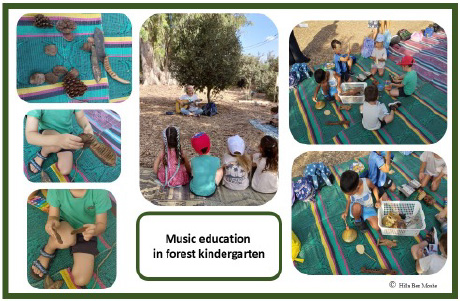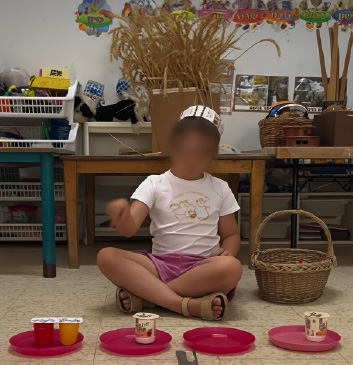Not just “playing around” – the transformative power of early childhood music education
Text: Hilla Ben-Moshe

Early childhood music education (ECME) has long been perceived as a field that does not require special knowledge and expertise, often dismissed as something “simple”—just singing songs, tapping rhythms, or keeping kids entertained. Consequently, ECME is frequently implemented by generalist teachers who receive little to not support, knowledge and training for teaching music to young children.
In this blog, I invite you to explore a different perspective—one shaped by my own experiences and reflections as an educator. I’ve come to believe that ECME can play a much more important role in connecting the individual practice with broader educational, social, and environmental systems. ECME can foster interconnected thinking, inspiring music educators to reimagine their roles in relation to pressing issues like democracy, inclusion, and environmental responsibility.
As opposite to higher music education in which the musical practices are narrowed down to music specific, craft-based competences (Westerlund, & López-Íñiguez, 2024a), the field of ECME is characterized by boundary-crossing, where music-making intertwines with dance, drama, visual arts, and storytelling. Through these interrelated creative activities, even before entering school, children can enrich their social development, deepen cultural awareness, and build meaningful connections to the environment. When approached with care and purpose, ECME reminds us that music is for everyone and that it can be a powerful tool for connection and change.
The holistic nature of early childhood music pedagogy
Integrating the idea that music can express human emotions—such as joy, loss, and resilience—and mirror the cycles of nature into early music education helps children see themselves as part of an interconnected world, rather than an isolated bubble. For example, encouraging children to create music using natural elements like fruits Idle (as in the picture above) or stones fosters a deep appreciation for the environment. They begin to understand that the soundscapes of the natural world are just as meaningful and valuable as structured musical compositions with traditional instruments. Additionally, exploring how sound pollution disrupts natural harmony can raise awareness of environmental degradation. This perspective not only enriches children’s musical understanding but also shapes how they think about sustainability, conservation, and responsible living as they grow.
Just as music can foster environmental awareness, it can also illuminate social issues. In early childhood teaching, music naturally facilitates and encourages collaboration, inclusion, and empathy. When young children engage in musical play, they learn to listen, respond, and contribute to a collective soundscape, mirroring democratic values of dialogue and participation, and highlighting the moral importance of inclusivity, equity, and respect for diverse perspectives. Learning how to maintain one’s voice while valuing and respecting the contributions of others nurtures mutual understanding and belonging. When ECME integrates this awareness—teaching children that music is not just about individual talent but also about strengthening cultural and communal ties—it becomes a powerful force for shaping shared experiences and social consciousness (see further, Westerlund et al., in press).
The image below is from a video taken during a music lesson in a kindergarten in Israel (Bar Shalom, 2025). The girl “wrote” a rhythm she had composed using milk candy boxes as her notation. By guiding the other children to clap in synchrony with her rhythm—accompanying a traditional holiday song—she transformed her musical creation into a collective experience. This participatory activity strengthens social bonds and fosters engagement with the community’s cultural and religious heritage.

The practice of early childhood music teaching
Music offers powerful tools for human development, shaping emotional, cognitive, and social growth in early childhood. Therefore, professional training for a specialist teacher in ECME involves methods, approaches, and pedagogies, as well as a focus on the interactions and connections between children, their environments, and music. To deepen the understanding and significance of a holistic approach in the professional ECME practice, I draw on Theodor Schatzki’s practice theory (Schatzki, 2001, 2002, 2019), which can be used to frame early childhood music teaching as a complex nexus of doings and sayings—where bodily actions, verbal expressions, and material arrangements come together to form meaningful, socially embedded practices.
ECME teaching expertise requires more than musicianship skills; it demands an understanding of the psychological, emotional, physical and social developmental of the child, and the ability to integrate these dimensions into practice. Through embodied activities such as movement, gesture, and vocalization, the body serves multiple functions: it manifests mental states by expressing sensations, emotions, and consciousness; it signifies cognitive conditions like desires, beliefs, hopes, and expectations; and it acts as an instrument for performing actions in specific situations (Hui et al., 2017; Schatzki, 1996, 2001).
By adopting a broader perspective on early childhood music teaching, we move beyond viewing it as a mere instructional method and recognize it as an embodied, socially embedded practice that shapes both teaching and learning experiences, as well as developmental outcomes. It’s not just “playing around.” The professional teacher must possess deep knowledge and expertise in order for the practice to be truly engaging, playful, and precise. This approach highlights ECME as an essential element of child development and social interaction.
Paradoxically, even as research increasingly underscores the vital role of music education in early childhood development, in some countries it continues to struggle for a place in early learning curricula (Barrett & Westerlund, 2017). Often, it is marginalized by early childhood educators who might lack confidence and competence in music education, and face challenges integrating music into everyday classroom life. As a result, the field is frequently dominated by private and commercial organizations—or is entirely omitted due to a lack of institutional support—limiting access to high-quality, structured music education. This disconnect between formal education systems and professionally trained music educators leads to inconsistent, often inadequate music experiences for children. Without institutional support, ECME risks being viewed as a privilege rather than a fundamental part of early education. To strengthen the practice of ECME, it is crucial to integrate music into formal early learning systems—through specialized training for preschool teachers and collaboration between professional music teachers and early childhood teachers, ensuring music becomes a natural part of daily kindergarten life.
Rethinking the music education system
As we recognize the profound impact music has on young learners, perhaps it is time to rethink how music education is structured. The challenge is not merely curricular—it is conceptual. Society must redefine what music education is for. By embracing a holistic vision, music education can create learning environments that prioritize engagement, inclusion, and interdisciplinary thinking, while embedding principles of sustainability.
Instead of viewing ECME as merely preparatory or dismissing it as insignificant “playing around,” it should be recognized as a vital source of insight for all music educators. If educators at every level draw inspiration from ECME and embrace its emphasis on cross-disciplinary connections, cultural awareness, and active participation, they can cultivate a more holistic and impactful professional practice—regardless of their students’ age. This shift disrupts traditional music education hierarchies and fosters inclusive, sustainable learning By linking early childhood care institutions and schools with conservatories and local musicians in intergenerational projects, music may become a shared experience that transcends traditional boundaries of community, discipline and age.
In conclusion, viewed through Schatzki’s lens, ECME can be seen as part of the broader plenum (Schatzki, 2019)—a web of interwoven practices shaped by technical, cultural, and political forces. Recognizing its place within this social fabric allows music education to foster inclusive, sustainable environments and challenge conventional hierarchies. By connecting institutions and generations, music becomes a shared, transformative practice. To sustain its relevance as a force for lifelong learning and social change, educators must actively collaborate across disciplines, advocate for meaningful policy reforms, and integrate music education into the surrounding communities.
References
- Barrett, M. S., & Westerlund, H. (2017). Practices of Music Education and Learning Across the Lifespan: An Exploration of Values and Purposes. In G. Barton & M. Baguley (Eds.), The Palgrave Handbook of Global Arts Education (pp. 75–89). Palgrave Macmillan UK. https://doi.org/10.1057/978-1-137-55585-4_5
- Bar Shalom, M. (3.6.2025). What happens when learning the language of music at a young age. [Reels from Facebook]. https://www.facebook.com/reel/688732420460355
- Hui, A., Schatzki, T. R., & Shove, E. (Eds.). (2017). The nexus of practices: Connections, constellations, practitioners. Routledge Taylor & Francis Group.
- Schatzki, T. R. (2001). Practice mind-ed orders. In K. K. Cetina, T. R. Schatzki, & E. von Savigny (Eds.), The practice turn in contemporary theory (pp. 50–62). Routledge.
- Schatzki, T. R. (2019). Social change in a material world (1st ed.). Routledge.
- Schatzki, T. R. (2002). The site of the social: A philosophical account of the constitution of social life and change. Penn State University Press.
- Westerlund, H., Laes, T., & López-Íñiguez, G. (in press). Toward sustainability beyond advocacy: Systems thinking for unlocking the transformative powers of music education. Action, Criticism, and Theory for Music Education.
- Westerlund, H., & López-Íñiguez, G. (2024). Contemporary composers’ changing “practice in context”: What can higher music education learn from Theodore Schatzki’s practice theory? Research Studies in Music Education, 47(2), 280–296. https://doi.org/10.1177/1321103X241249098
Art makes a difference
Taidekasvatuksen tutkimusverkosto CERADAn blogista löydät verkoston uutiset, tapahtumat ja puheenvuorot. Verkoston tutkijat kirjoittavat taidekasvatuksen tutkimuksesta sekä taidealan korkea-asteen koulutuksen tutkimusperustaisesta kehittämisestä. Tutkimusverkosto on osa Taideyliopiston Tutkimusinstituuttia.
Research network CERADA’s blog offers news and views about how research into arts education can have an impact on society. CERADA researchers at Uniarts Helsinki blog about their work. The research network is part of Uniarts Helsinki Research Institute.
Latest posts
-
Call for participants: Societal engagement as part of studying in Sibelius Academy
-
Why Stories, Culture, and the Arts Matter for Health and Well-being
-
Taide ja kulttuuri demokratian tukipilareina: kohti tasa-arvoisempaa yhteiskuntaa
Follow blog